George Walker Bush (born July 6, 1946) is an American politician and businessman who served as the 43rd President of the United States of America from 2001 to 2009[4] and the 46th Governor of Texas from 1995 to 2000. The eldest son of Barbara and George H. W. Bush, he was born in New Haven, Connecticut. After graduating from Yale University in 1968 and Harvard Business School in 1975, Bush worked in oil businesses. He married Laura Welch in 1977 and ran unsuccessfully for the House of Representatives shortly thereafter. He later co-owned theTexas Rangers baseball team before defeating Ann Richards in the 1994 Texas gubernatorial election. Bush was elected president in 2000 after a close and controversial election, becoming the fourth president to be elected while receiving fewer popular votes nationwide than his opponent.[5] Bush is the second president to have been the son of a former president, the first beingJohn Quincy Adams (with the other familial presidential relations being grandfather-grandson of the Harrisons, as well as the Roosevelts being 5th cousins).[6] He is also the brother of Jeb Bush, former Governor of Florida.
Eight months into Bush's first term as president, the September 11, 2001 terrorist attacks occurred. In response, Bush announced the War on Terror, an international military campaign which included the war in Afghanistan launched in 2001 and the war in Iraq launched in 2003. In addition to national security issues, Bush also promoted policies on the economy, health care, education, social security reform, and amending the Constitution to disallow same-sex marriage.[7] He signed into law broad tax cuts, the PATRIOT Act, the No Child Left Behind Act, thePartial-Birth Abortion Ban Act, Medicare prescription drug benefits for seniors, and funding for the AIDS relief program known as PEPFAR. Bush announced the U.S. would not implement theKyoto Protocol on global warming that had been negotiated by the Clinton Administration in 1997, and agreed to by 178 other countries, but never ratified by the U.S. Senate.[8][9] His tenure saw national debates on immigration, Social Security, electronic surveillance, and enhanced interrogation techniques.
Bush successfully ran for re-election against Democratic Senator John Kerry in 2004, in another relatively close election. After his re-election, Bush received increasingly heated criticism from across the political spectrum[10][11][12] for his handling of the Iraq War, Hurricane Katrina,[13][14][15] and numerous other challenges. As a result, the Democratic Party won control of Congress in the 2006 elections. In December 2007, the United States entered its longest post–World War II recession, often referred to as the "Great Recession", prompting the Bush Administration to enact multiple economic programs intended to preserve the country's financial system. Nationally, Bush was both one of the most popular and unpopular presidents in history, having received the highest recorded presidential approval ratings in the wake of 9/11, as well as one of the lowest approval ratings during the 2008 financial crisis.[16] Internationally, he was a highly controversial figure, with public protests occurring even during visits to close allies, such as the United Kingdom.[17]
Bush left office in 2009, and was succeeded as president by Barack Obama, who ran on a platform of change from Bush's policies. Since leaving office, Bush has returned to Texas and purchased a home in a suburban area of Dallas. He is currently a public speaker, has written a memoir entitled Decision Points,[18] and his presidential library was opened in 2013. Although his presidency has been ranked among the worst in recent surveys of presidential scholars,[19][20] his favorability ratings among the public have improved since he left office.[21][22][23]
Contents
[show]Childhood to mid-life
Main article: Early life of George W. Bush
George Walker Bush was born in New Haven, Connecticut, at Grace-New Haven Hospital (now Yale – New Haven Hospital), on July 6, 1946,[24] the first child of George Herbert Walker Bushand Barbara Pierce. He was raised in Midland and Houston, Texas, with four siblings, Jeb, Neil, Marvin and Dorothy. Another younger sister, Robin, died from leukemia at the age of three in 1953.[25] Bush's grandfather, Prescott Bush, was a U.S. Senator from Connecticut.[26] Bush's father, George H. W. Bush, was Vice President from 1981 to 1989 and President from 1989 to 1993. Bush has English and some German ancestry, along with more distant Dutch, Welsh, Irish, French, and Scottish roots.[27]
Education
Bush attended public schools in Midland, Texas, until the family moved to Houston after he completed seventh grade. He then went to The Kinkaid School, a prep school in Houston, for two years.[28]
Bush finished high school at Phillips Academy, a boarding school (then all-male) in Andover, Massachusetts, where he played baseball and during his senior year was the head cheerleader.[29][30] Bush attended Yale University from 1964 to 1968, graduating with an B.A. in history.[31] During this time, he was a cheerleader and a member of the Delta Kappa Epsilon, being elected the fraternity's president during his senior year.[32][33][34] Bush also became a member of the Skull and Bones society as a senior.[35] Bush was a rugby union player and was on Yale's 1st XV.[36] He characterized himself as an average student.[37] His average during his first three years at Yale was 77 and he had a similar average under a nonnumeric rating system in his final year.[38]
Beginning in the fall of 1973, Bush attended the Harvard Business School, where he earned a Master of Business Administration. He is the only U.S. President to have earned an M.B.A.[39]
Texas Air National Guard
In May 1968, Bush was commissioned into the Texas Air National Guard.[40] After two years of active-duty service while training,[41] he was assigned to Houston, flying Convair F-102s with the 147th Reconnaissance Wing out of Ellington Field Joint Reserve Base.[40][42] Critics, including former Democratic National Committee Chairman Terry McAuliffe, have alleged that Bush was favorably treated due to his father's political standing as a member of the House of Representatives, citing his selection as a pilot despite his low pilot aptitude test scores and his irregular attendance.[43] In June 2005, the United States Department of Defense released all the records of Bush's Texas Air National Guard service, which remain in its official archives.[44]
In late 1972 and early 1973, he drilled with the 187th Fighter Wing of the Alabama Air National Guard, having moved to Montgomery, Alabama to work on the unsuccessful U.S. Senate campaign of Republican Winton M. Blount.[45][46] In 1972, Bush was suspended from flying for failure to take a scheduled physical exam.[47] He was honorably discharged from the Air Force Reserve on November 21, 1974.[48]
Marriage, family, and personal life
See also: Bush family
At a backyard barbecue in 1977, friends introduced him to Laura Lane Welch, a school teacher and librarian. Bush proposed to her after a three-month courtship, and they married on November 5 of that year.[49] The couple settled in Midland, Texas. Bush left his family's Episcopal Church to join his wife'sUnited Methodist Church.[2] On November 25, 1981, Laura Bush gave birth to fraternal twin daughters, Barbara Pierce Bush and Jenna Welch Bush;[49] they graduated from high school in 2000 and from the University of Texas at Austin and Yale University, respectively, in 2004.
Prior to his marriage, Bush had multiple episodes of alcohol abuse.[50] In one instance, on September 4, 1976, he was arrested near his family's summer home in Kennebunkport, Maine, for driving under the influence of alcohol. He pleaded guilty, was fined $150 and had his Maine driver's license suspended until 1978.[51] Bush's alleged drug usage is less clear; when asked about alleged past illicit drug use, Bush has consistently refused to answer. He defended his refusal to answer in a publicized casual conversation with a friend, saying that he feared setting a bad example for the younger generation.[52][53][54]
Bush says his wife has had a stabilizing effect on his life,[49] and attributes to her influence his 1986 decision to give up alcohol.[55] While Governor of Texas, Bush said of his wife, "I saw an elegant, beautiful woman who turned out not only to be elegant and beautiful, but very smart and willing to put up with my rough edges, and I must confess has smoothed them off over time."[49]
Bush mostly reads "serious historical nonfiction" for pleasure. During his time as president, Bush read 14 Lincoln biographies and, during the last three years of his presidency, he reportedly read 186 books. A reporter recalls seeing "books by John Fowles, F. Scott Fitzgerald, James Joyce, and Gore Vidal lying about, as well as biographies of Willa Cather and Queen Victoria" in his home when Bush was a Texas oilman. Other hobbies include cigar smoking and golf.[56] Since leaving the White House, Bush has also taken up oil painting.[57]
Bush welcomed his first granddaughter, Margaret Laura "Mila" Hager on April 14, 2013, when his daughter Jenna Bush gave birth. Margaret is named after her two grandmothers.[58]
Early career
Main article: Professional life of George W. Bush
In 1978, Bush ran for the House of Representatives from Texas's 19th congressional district. His opponent, Kent Hance, portrayed him as out of touch with rural Texans. Bush lost the election by 6,000 votes (6%) of the 103,000 votes cast.[59] He returned to the oil industry and began a series of small, independent oil exploration companies.[60] He created Arbusto Energy,[61] and later changed the name to Bush Exploration. In 1984, his company merged with the larger Spectrum 7, and Bush became chairman.[60] The company was hurt by decreased oil prices, and it folded into HKN, Inc.[60][62]Bush served on the board of directors for HKN.[60] Questions of possible insider trading involving HKN arose, but the Securities and Exchange Commission's (SEC) investigation concluded that the information Bush had at the time of his stock sale was not sufficient to constitute insider trading.[60][63]
Bush moved his family to Washington, D.C. in 1988 to work on his father's campaign for the U.S. presidency.[64][65] He served as a campaign adviser and liaison to the media;[60] he assisted his father by campaigning across the country.[60] Returning to Texas after the successful campaign, he purchased a share in the Texas Rangers baseball franchise in April 1989, where he served as managing general partner for five years.[66] He actively led the team's projects and regularly attended its games, often choosing to sit in the open stands with fans.[67] Bush's sale of his shares in the Rangers in 1998 brought him over $15 million from his initial $800,000 investment.[68]
In December 1991, Bush was one of seven people named by his father to run his father's 1992 Presidential re-election campaign as "campaign advisor".[69] The prior month, his father asked him to tell White House chief of staff John H. Sununu that he should resign.[70]
Governor of Texas
Main article: Governorship of George W. Bush
As Bush's brother, Jeb, sought the governorship of Florida, Bush declared his candidacy for the 1994 Texas gubernatorial election. His campaign focused on four themes: welfare reform, tort reform, crime reduction, and education improvement.[60] Bush's campaign advisers were Karen Hughes, Joe Allbaugh, and Karl Rove.[71]
After easily winning the Republican primary, Bush faced popular Democratic incumbent Governor Ann Richards.[60][72] In the course of the campaign, Bush pledged to sign a bill allowing Texans to obtain permits to carry concealed weapons. Richards had vetoed the bill, but Bush signed it after he became governor.[73] According to The Atlantic Monthly, the race "featured a rumor that she was a lesbian, along with a rare instance of such a tactic's making it into the public record – when a regional chairman of the Bush campaign allowed himself, perhaps inadvertently, to be quoted criticizing Richards for 'appointing avowed homosexual activists' to state jobs".[74] The Atlantic, and others, connected the lesbian rumor to Karl Rove,[75] but Rove denied being involved.[76] Bush won the general election with 53.5% against Richards' 45.9%.[77]
Bush used a budget surplus to push through Texas's largest tax-cut, $2 billion.[71] He extended government funding for organizations providing education of the dangers of alcohol and drug use and abuse, and helping to reduce domestic violence.[78] Critics contended that during his tenure, Texas ranked near the bottom in environmental evaluations, but supporters pointed to his efforts to raise the salaries of teachers and improve educational test scores.[60]
In 1999, Bush also helped make Texas eventually the leading producer of wind powered electricity in the U.S.[79][80][81] by signing a state law obliging electric retailers to buy a certain amount of energy from renewable sources (RPS).[82][83][84]
In 1998, Bush won re-election with a record[60] 69% of the vote.[85] He became the first governor in Texas history to be elected to two consecutive four-year terms.[60] For most of Texas history, governors served two-year terms; aconstitutional amendment extended those terms to four years starting in 1975.[86] In his second term, Bush promoted faith-based organizations and enjoyed high approval ratings.[60] He proclaimed June 10, 2000 to be Jesus Day in Texas, a day on which he "urge[d] all Texans to answer the call to serve those in need".[87]
Throughout Bush's first term, national attention focused on him as a potential future presidential candidate. Following his re-election, speculation soared.[60] Within a year, he decided to seek the 2000 Republican presidential nomination.
Presidential campaigns
2000 Presidential candidacy
Main article: United States presidential election, 2000
Primary
In June 1999, while Governor of Texas, Bush announced his candidacy for President of the United States. With no incumbent running, Bush entered a large field of candidates for the Republican Party presidential nomination consisting of John McCain, Alan Keyes, Steve Forbes, Gary Bauer, Orrin Hatch, Elizabeth Dole, Dan Quayle, Pat Buchanan, Lamar Alexander, John Kasich, andRobert C. Smith.
Bush portrayed himself as a compassionate conservative, implying he was more centrist than other Republicans. He campaigned on a platform that included bringing integrity and honor back to the White House, increasing the size of the United States Armed Forces, cutting taxes, improving education, and aiding minorities.[60] By early 2000, the race had centered on Bush and McCain.[60]
Bush won the Iowa caucuses, but, although he was heavily favored to win the New Hampshire primary, he trailed McCain by 19% and lost that primary. Despite this, Bush regained momentum and, according to political observers, effectively became the front runner after the South Carolina primary, which according to The Boston Globe made history for his campaign's negativity; The New York Times described it as a smear campaign.[88][89][90]
General election
On July 25, 2000, Bush surprised some observers by asking Dick Cheney, a former White House Chief of Staff, U.S. Representative, and Secretary of Defense, to be his running mate. Cheney was then serving as head of Bush's Vice-Presidential search committee. Soon after, Cheney was officially nominated by the Republican Party at the 2000 Republican National Convention.
Bush continued to campaign across the country and touted his record as Governor of Texas.[60] Bush's campaign criticized his Democratic opponent, incumbent Vice President Al Gore, over gun control and taxation.[91]
When the election returns came in on November 7, Bush won 29 states, including Florida. The closeness of the Florida outcome led to a recount.[60] The initial recount also went to Bush, but the outcome was tied up in courts for a month until reaching the U.S. Supreme Court.[92] On December 9, in a controversial ruling[93] the Bush v. Gore case the Court reversed a Florida Supreme Court decision ordering a third count, and stopped an ordered statewide hand recount based on the argument that the use of different standards among Florida's counties violated the Equal Protection Clause of the Fourteenth Amendment.[60] The machine recount showed that Bush had won the Florida vote by a margin of 537 votes out of six million cast.[94] Although he received 543,895 fewer individual votes than Gore nationwide, Bush won the election, receiving 271 electoral votes to Gore's 266.[94]
2004 Presidential candidacy
Main article: United States presidential election, 2004
In 2004, Bush commanded broad support in the Republican Party and did not encounter a primary challenge. He appointed Ken Mehlman as campaign manager, with a political strategy devised by Karl Rove.[95] Bush and the Republican platform included a strong commitment to the wars in Iraq and Afghanistan,[96] support for the USA PATRIOT Act,[97] a renewed shift in policy for constitutional amendments banning abortion and same-sex marriage,[96][98] reforming Social Security to create private investment accounts,[96] creation of an ownership society,[96] and opposing mandatory carbon emissions controls.[99] Bush also called for the implementation of a guest worker program for immigrants,[96] which was criticized by conservatives.[100]
The Bush campaign advertised across the U.S. against Democratic candidates, including Bush's emerging opponent, Massachusetts Senator John Kerry. Kerry and other Democrats attacked Bush on the Iraq War, and accused him of failing to stimulate the economy and job growth. The Bush campaign portrayed Kerry as a staunch liberal who would raise taxes and increase the size of government. The Bush campaign continuously criticized Kerry's seemingly contradictory statements on the war in Iraq,[60] and argued that Kerry lacked the decisiveness and vision necessary for success in the War on Terror.
In the election, Bush carried 31 of 50 states, receiving a total of 286 electoral votes. He won an outright majority of the popular vote (50.7% to his opponent's 48.3%).[101] The previous President to win an outright majority of the popular vote was Bush's father in the 1988 election. Additionally, it was the first time since Herbert Hoover's election in 1928 that a Republican president was elected alongside re-elected Republican majorities in both Houses of Congress.
Presidency
Main articles: Presidency of George W. Bush, George W. Bush's first term as President of the United States, and George W. Bush's second term as President of the United States
Though Bush originally outlined an ambitious domestic agenda, his priorities were significantly altered following the September 11 terrorist attacks in 2001.[102] Wars were waged in Afghanistan and Iraq with significant domestic debates regarding immigration, healthcare, Social Security, economic policy, and treatment of terrorist detainees. Over an eight-year period, Bush's once-high approval ratings[103] steadily declined, while his disapproval numbers increased significantly.[104] In 2007, the United States entered the longest post-World War II recession.[105]
Domestic policy
Main article: Domestic policy of the George W. Bush administration
Economic policy
Main article: Economic policy of the George W. Bush administration
Bush took office during a period of economic recession in the wake of the bursting of the Dot-com bubble.[106] The terrorist attacks also impacted the economy. The Bush administration increased federal government spending from $1.789 trillion to $2.983 trillion (60%) while revenues increased from $2.025 trillion to $2.524 trillion (from 2000 to 2008). Individual income tax revenues increased by 14%, corporate tax revenues by 50%, customs and duties by 40%. Discretionary defense spending was increased by 107%, discretionary domestic spending by 62%, Medicare spending by 131%, social security by 51%, and income security spending by 130%. Cyclically adjusted, revenues rose by 35% and spending by 65%.[107]
The increase in spending was more than under any predecessor since Lyndon B. Johnson.[108] The number of economic regulation governmental workers increased by 91,196.[109]
The surplus in fiscal year 2000 was $237 billion—the third consecutive surplus and the largest surplus ever.[110] In 2001, Bush's budget estimated that there would be a $5.6 trillion surplus over the next ten years.[111] Facing congressional opposition, Bush held townhall style meetings across the U.S. in order to increase public support for his plan for a $1.35 trillion tax cut program—one of the largest tax cuts in U.S. history.[60] Bush argued that unspent government funds should be returned to taxpayers, saying "the surplus is not the government’s money. The surplus is the people’s money."[60]Federal Reserve Chairman Alan Greenspan warned of a recession and Bush stated that a tax cut would stimulate the economy and create jobs.[112] Treasury Secretary Paul O'Neill, opposed some of the tax cuts on the basis that they would contribute to budget deficits and undermine Social Security.[113] O'Neill disputes the claim, made in Bush's book Decision Points, that he never openly disagreed with him on planned tax cuts.[114] By 2003, the economy showed signs of improvement, though job growth remained stagnant.[60] Another tax cut program was passed that year.
During the 2001 to 2008 years, GDP grew at an average annual rate of 2.125%,[115] less than for past business cycles.[116]
Bush entered office with the Dow Jones Industrial Average at 10,587, and the average peaked in October 2007 at over 14,000. When Bush left office, the average was at 7,949, one of the lowest levels of his presidency.[117]
Unemployment originally rose from 4.2% in January 2001 to 6.3% in June 2003, but subsequently dropped to 4.5% as of July 2007.[118]Adjusted for inflation, median household income dropped by $1,175 between 2000 and 2007,[119] while Professor Ken Homa of Georgetown University has noted that "after-tax median household income increased by 2%"[120] The poverty rate increased from 11.3% in 2000 to 12.3% in 2006 after peaking at 12.7% in 2004.[121] By October 2008, due to increases in spending,[122] the national debt had risen to $11.3 trillion,[123] an increase of over 100% from 2000 when the debt was only $5.6 trillion.[124][125] Most debt was accumulated as a result of what became known as the "Bush tax cuts" and increased national security spending.[126] In March 2006, then-Senator Barack Obama said when he voted against raising the debt ceiling: "The fact that we are here today to debate raising America’s debt limit is a sign of leadership failure."[127] By the end of Bush's presidency, unemployment climbed to 7.2%.[128]
In December 2007, the United States entered the longest post–World War II recession,[129] which included a housing market correction, a subprime mortgage crisis, soaring oil prices, and a declining dollar value.[130] In February, 63,000 jobs were lost, a five-year record.[131][132] To aid with the situation, Bush signed a $170 billion economic stimulus package which was intended to improve the economic situation by sending tax rebate checks to many Americans and providing tax breaks for struggling businesses. The Bush administration pushed for significantly increased regulation of Fannie Mae and Freddie Mac in 2003,[133] and after two years, the regulations passed the House but died in the Senate. Many Republican senators, as well as influential members of the Bush Administration, feared that the agency created by these regulations would merely be mimicking the private sector’s risky practices.[134][135] In September 2008, the crisis became much more serious beginning with the government takeover of Fannie Mae and Freddie Macfollowed by the collapse of Lehman Brothers and a federal bailout of American International Group for $85 billion.[136]
Many economists and world governments determined that the situation became the worst financial crisis since the Great Depression.[137][138] Additional regulation over the housing market would have been beneficial, according to former Federal Reserve Chairman Alan Greenspan.[139] Bush, meanwhile, proposed a financial rescue plan to buy back a large portion of the U.S. mortgage market.[140] Vince Reinhardt, a former Federal Reserve economist now at theAmerican Enterprise Institute, said "it would have helped for the Bush administration to empower the folks at Treasury and the Federal Reserve and the comptroller of the currency and the FDIC to look at these issues more closely", and additionally, that it would have helped "for Congress to have held hearings".[135]
In November 2008, over 500,000 jobs were lost, which marked the largest loss of jobs in the United States in 34 years.[141] The Bureau of Labor Statistics reported that in the last four months of 2008, 1.9 million jobs were lost.[142] By the end of 2008, the U.S. had lost a total of 2.6 million jobs.[143]
Education and health
Bush undertook a number of educational priorities, such as increasing the funding for the National Science Foundation and National Institutes of Health in his first years of office, and creating education programs to strengthen the grounding in science and mathematics for American high school students. Funding for the NIH was cut in 2006, the first such cut in 36 years, due to rising inflation.[144]
One of the administration's early major initiatives was the No Child Left Behind Act, which aimed to measure and close the gap between rich and poor student performance, provide options to parents with students in low-performing schools, and target more federal funding to low-income schools. This landmark education initiative passed with broad bipartisan support, including that of Senator Ted Kennedy of Massachusetts.[145] It was signed into law by Bush in early 2002.[146] Many contend that the initiative has been successful, as cited by the fact that students in the U.S. have performed significantly better on state reading and math tests since Bush signed "No Child Left Behind" into law.[147] Critics argue that it is underfunded[148] and that NCLBA's focus on "high stakes testing" and quantitative outcomes is counterproductive.[149]
After being re-elected, Bush signed into law a Medicare drug benefit program that, according to Jan Crawford Greenburg, resulted in "the greatest expansion in America's welfare state in forty years;" the bill's costs approached $7 trillion.[150] In 2007, Bush opposed and vetoed State Children's Health Insurance Program (SCHIP) legislation, which was added by the Democrats onto a war funding bill and passed by Congress. The SCHIP legislation would have significantly expanded federally funded health care benefits and plans to children of some low-income families from about six million to ten million children. It was to be funded by an increase in the cigarette tax.[151] Bush viewed the legislation as a move toward socialized health care, and asserted that the program could benefit families making as much as $83,000 per year who did not need the help.[152]
Social services and Social Security
Following Republican efforts to pass the Medicare Act of 2003, Bush signed the bill, which included major changes to the Medicare program by providing beneficiaries with some assistance in paying for prescription drugs, while relying on private insurance for the delivery of benefits.[153] The retired persons lobby group AARP worked with the Bush Administration on the program and gave their endorsement. Bush said the law, estimated to cost $400 billion over the first ten years, would give the elderly "better choices and more control over their health care".[154]
Bush began his second term by outlining a major initiative to reform Social Security,[155] which was facing record deficit projections beginning in 2005. Bush made it the centerpiece of his domestic agenda despite opposition from some in the U.S. Congress.[155] In his 2005 State of the Union Address, Bush discussed the potential impending bankruptcy of the program and outlined his new program, which included partial privatization of the system, personal Social Security accounts, and options to permit Americans to divert a portion of their Social Security tax (FICA) into secured investments.[155] Democrats opposed the proposal to partially privatize the system.[155]
Bush embarked on a 60-day national tour, campaigning vigorously for his initiative in media events, known as the "Conversations on Social Security", in an attempt to gain support from the general public.[156] Despite the energetic campaign, public support for the proposal declined[157] and the House Republican leadership decided not to put Social Security reform on the priority list for the remainder of their 2005 legislative agenda.[158] The proposal's legislative prospects were further diminished by the political fallout from the Hurricane Katrina in the fall of 2005.[159]After the Democrats gained control of both houses of the Congress as a result of the 2006 midterm elections, the prospects of any further congressional action on the Bush proposal were dead for the remainder of his term in office.



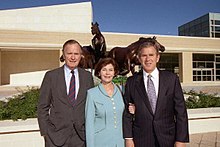

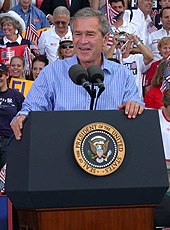

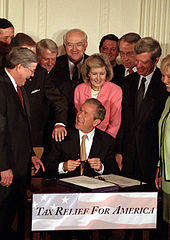
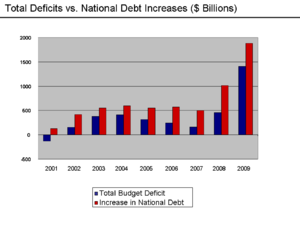

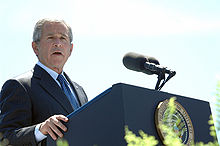
No comments:
Post a Comment